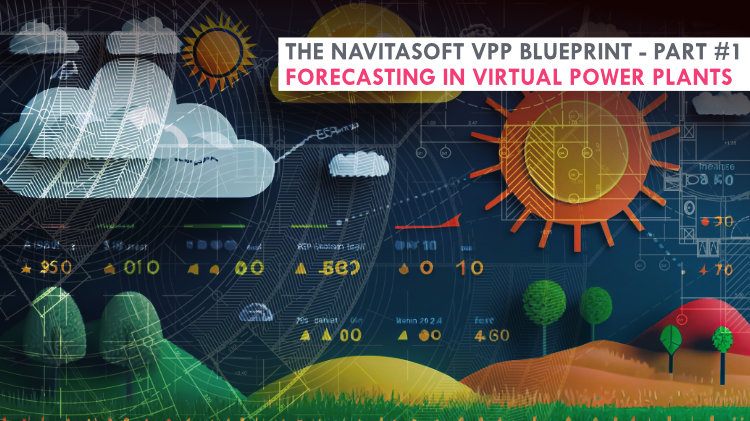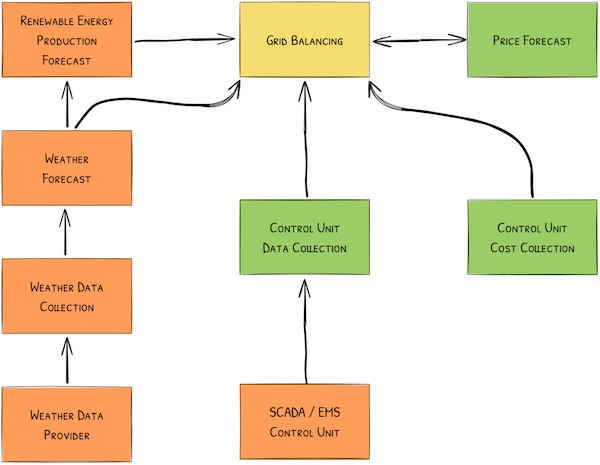
The International Energy Agency (IEA) has recently unveiled staggering statistics on the global renewable capacity. Their projections indicate a monumental surge of 107 gigawatts (GW), marking the biggest absolute capacity addition with over 440 GW by 2023. While these numbers paint a promising picture for the future of renewable energy, they also underscore the intricate challenges that lie ahead, especially in the management of this energy - concretely, the balancing of the grids.
Because with more renewable energy in the mix, matching demand with supply is getting more difficult, hence having precise forecasts is must - whether you operate a traditional power plant, a solar park, a wind farm, or a Virtual Power Plant (VPP). The latter is still considered to be a big unknown in the industry, but forecasting is equally, if not more important in operating a VPP. This is why in our first installment of our series on our “VPP blueprint”, we want to help you make your VPP stand tall in the new dynamic energy markets by nailing the first important pillar that is forecasting.
In the energy future, forecasting will be a key component, as it will act as the basis for all decision-making and control actions in VPPs. But here forecasting isn't merely about predicting tomorrow's weather; it delves deeper into understanding the intrinsic value of a particular asset at specific times of the day. Such predictions answer important questions:
- What is the potential output of an asset?
- When is it most flexible in its offerings?
- How do general market conditions, such as abundant sunshine or gusty winds, influence these factors?
While the technical aspects may be a bit complex, forecasting is an integral part of a successful VPP, which should not be overlooked. Here's a breakdown of what this involves:

1. Weather Data Collection and Forecasting
- In the bottom left corner we lay the cornerstone with the primary source of all meteorological data, which provides real-time and historical weather data that is crucial for predicting renewable energy source's (RES) production.
- The next step involves gathering and storing data from the weather data provider. It ensures that the VPP has access to a continuous stream of updated weather information.
- Using the collected data, predictions about future weather conditions are made. This forecast, whether it's about sunlight, wind speed, or other relevant factors, directly impacts the RES production forecast.
2. RES Production Forecast
Based on the weather forecast, the VPP predicts the amount of energy that renewable sources, like solar panels or wind turbines, will produce. This forecast is vital to determine how much energy will be available for distribution and at what times.
3. Control Unit Data and Cost
Now coming in from the right side in the middle is the Control Unit Data Collection, which involves gathering data from various control units within the VPP. These units can be individual energy-producing assets like solar arrays or wind turbines, or consumption and storage points such as heat pumps, battery storage or electric vehicle charging stations. If non-RES assets are part of the VPP, the costs associated with activating these assets, such as fuel costs, are considered. This data is crucial for making cost-effective decisions about which assets to activate and when.
4. Grid Balancing
Integrating all the above data points in the top center, the VPP predicts its overall production and consumption. This forecast considers the RES production forecast, control unit data, and associated costs and delivers a Price Forecast, which is an iterative process where the predicted prices of energy influence the grid supply & demand forecast, and vice versa. It helps the VPP determine the most cost-effective times to produce or consume energy.
Implications
This type of forecasting is the foundation of all VPP operations. It helps determine the value of a particular asset and its potential output. For accurate forecasting, an asset owner requires at least weather data or a weather forecast service. This data helps predict asset production, demand, and overall market conditions.
However, you must approach forecasting with a grain of salt. A forecast, by nature, is an educated prediction, and it's never foolproof. If outcomes align perfectly with forecasts, it's actually a cue to probe deeper, as this could hint at anomalies or even fraudulent activities. This inherent unpredictability shapes the decisions a VPP makes, influencing which devices to activate or deactivate and the optimal timing for such actions.
Peeking across the pond
Every country that is laying the groundwork for renewable energies faces the same challenges, also in forecasting, so for Europe, the U.S. is a good case to look at and learn from. In the U.S., the National Renewable Energy Laboratory (NREL) has highlighted the importance of accurate forecasting for wind and solar energy. These variable renewable energy (VRE) resources require advanced integration tools for power systems. The NREL report outlines various forecasting methods, including both physical and statistical approaches. While wind energy forecasting is well-established, solar forecasting is emerging, leveraging advanced tools like sky imagers and satellite imaging. Centralized forecasting, managed by balancing authorities, is favored for its consistency and cost-effectiveness, and there's a continuous push for advanced IT integration and training for system operators to adapt to the evolving energy landscape.
Luckily, ENTSO-E, the European Network of Transmission System Operators for Electricity, is at the forefront of all these challenges. As the stewards of the grid, these operators are grappling with the transformative changes ushered in by renewable production. Recognizing the need for enhanced forecasting capabilities, they're channeling investments into pioneering projects. One such initiative zeroes in on enhanced RES infeed forecasting, particularly for wind.
Forecasting Builds the Future of VPPs
The energy industry's ability to manage its renewable growth will hinge on the accuracy and sophistication of forecasting methods. Just as a skilled architect draws up blueprints that anticipate the load-bearing needs of a structure, so must the energy industry design its forecasting models to withstand the variable pressures of supply and demand. Especially VPPs owners should take this to heart, as their mix of assets requires profound forecasting for an effective utilization. With advancements in technology, like machine learning and artificial intelligence, forecasting tools are becoming more sophisticated, offering higher accuracy levels. The future in energy is clearly built on these innovative technologies.
The Navitasoft VPP Blueprint
Follow our complete series on VPPs and the digital solutions needed to run them:
Part 1: Forecasting in virtual power plants
Part 2: Integrating virtual power plants
Part 3: Internal system integration and reporting
Part 4: Optimization in Virtual Power Plants
Part 5: Trading Strategies to Optimize Your VPP
Part 6: How to Manage Risk for Your Virtual Power Plant
Part 7: Dispatching & control of execution in virtual power plants
Part 8: Disaggregation and settlement in virtual power plants
Part 9: VPP 3.0 - The Third Generation of Virtual Power Plants




